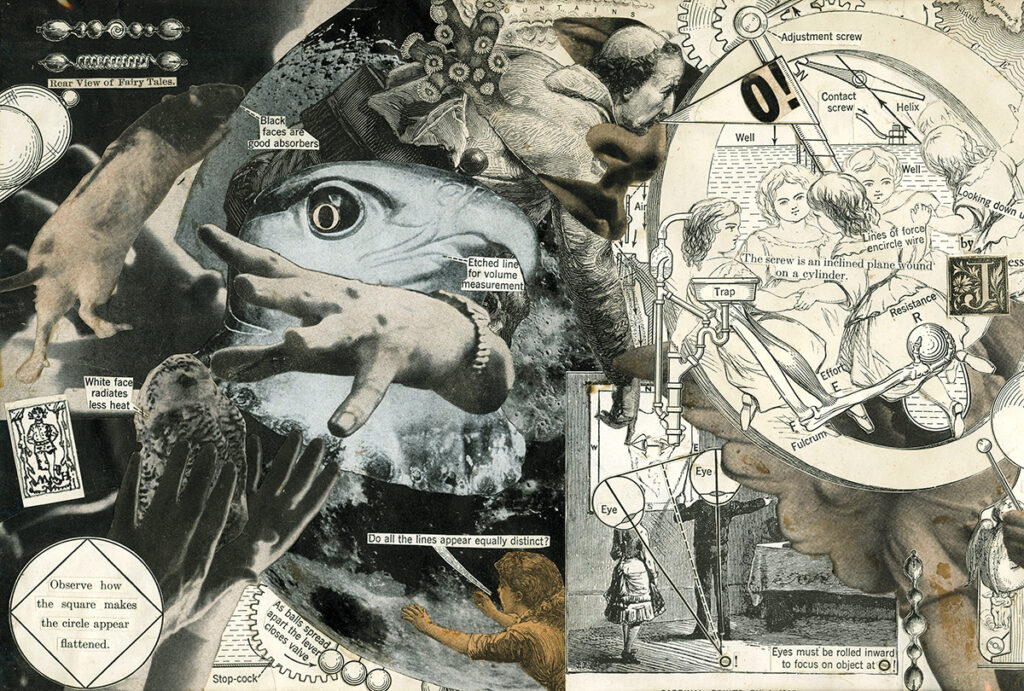Jess, Master of the Collage AestheticMichael Duncan
excerpts, 12/26/12
Originally published in O! Tricky Cad & Other Jessoterica, edited by Michael Duncan, Siglio, 2011. All rights reserved. © 2011 Michael Duncan.
Jess (1923–2004) was a quietly independent Bay Area artist and poet who developed a complex synthesis of art and literary history in his paintings, collages, and sculptures. Born Burgess Collins in Long Beach, California, Jess was trained as a chemist and worked during World War II on the production of plutonium for the Manhattan Project. Experiencing extreme anxiety over the ramifications of his atomic energy work, he had a dream in 1948 that prophesied the devastation of the world in 1975. Eight weeks after the dream, Jess abandoned science and his surname and moved to San Francisco to enroll in the California School of Fine Arts, then in its heyday with a faculty that included Clyfford Still, David Park, Elmer Bischoff, and Edward Corbett. In 1950 Jess met poet Robert Duncan and embarked on a domestic relationship of shared esthetic concerns that lasted until Duncan’s death in 1988.
Duncan and Jess came to artistic maturity together, ever expanding and refining a study of world literature and art focused on myths, symbols, and archetypes. In Caesar’s Gate, their first important collaboration, Jess’s collages provide a direct visual complement to a group of Duncan’s poems completed in 1955 while the couple was on an extended visit to Majorca. Duncan and Jess became crucial participants in the burgeoning Bay Area poetry and art scenes, developing close friendships with Helen Adam, Kenneth Anger, Wallace and Shirley Berman, Robin Blaser, James Broughton, George Herms, Patricia and Lawrence Jordan, Pauline Kael, Michael McClure, Charles Olson and Jack Spicer. Along with painter Harry Jacobus, Jess and Duncan ran the King Ubu Gallery in 1952-53, hosting exhibitions of work by Elmer Bischoff, David Park, Hassel Smith, and Jess himself. The couple set up their homes as havens dedicated to their collections of books, esoteric lore, and the art of their friends.
Jess’s mature art is about the retrieval of images from a culture overflowing with them. Fully embracing a collage esthetic, he created odd interminglings and fantastic juxtapositions, using images taken from sources ranging from Dick Tracy to Dürer, from a Beatles bubblegum card to medical textbook drawings, from 1887 Scientific American line engravings to frames from George Herriman’s Krazy Kat. Jess filtered these far-flung references through a self-described Romantic sensibility, one that valued the transforming power of the imagination above all else. Jess’s collages—which he called Paste-Ups—used cutout advertising images and slogans to present a satirical, absurdist view of sexuality and politics. As Jess grew obsessed with myth and archetype, his collages became intricate fields of clotted and amalgamated images that convey what he called “a network of stories.”
His self-reflexive style of image-making was most powerfully conveyed in the Translations (1959–76), a group of thirty-two paintings of appropriated images from unusual photographs, prints, and drawings, rendered in the manner of schematically outlined and colored canvases. In reworking the black-and-white source images, he gave the paintings a color scheme that doesn’t necessarily coincide with their graphic images and that often yields an abstract visual effect. Jess also correlated each found image with a pertinent text—from Plato, William Blake, Gertrude Stein, and others—which he inscribed on the back of the canvas.
Jess’s final project was the 6-by-5 foot drawing Narkissos (1976-1991), an intricate tableau of dense imagery spun off from the symbolic meanings of the Greek myth and now in the collection of the San Francisco Museum of Modern Art. In reexamining myths through a synthesis of art and literature, Jess’s work remains a crucial assemblage of the meaning of our time.
A retrospective, curated by Michael Auping, was organized by the Albright-Knox Art Gallery in Buffalo in 1993 and traveled to the Walker Art Center, the San Francisco Museum of Art, the Museum of Fine Arts Boston, and the Whitney Museum of American Art. Jess’s work is the centerpiece of the 2013-14 exhibition, An Opening of the Field: Jess, Robert Duncan & Their Circle organized by Michael Duncan and Christopher Wagstaff for the Crocker Art Museum and traveling to Grey Art Gallery, New York University; Katzen Art Gallery, American University; and the Pasadena Museum of California Art. His work resides in numerous private and public collections including those of the Museum of Modern Art, the Philadelphia Museum of Art, the Hirshhorn Museum and Sculpture Garden, the Art Institute of Chicago, and the Metropolitan Museum of Art.
see also
✼ consideration:
“Here Comes Kitty: A Comic Opera … achieves the hidden aim of all postmodern work. Namely, befuddling the reader with the dilemma: is this sheer brilliance? Or merely incomprehensible nonsense?”
[...]
